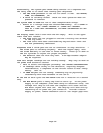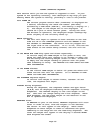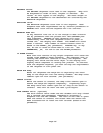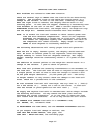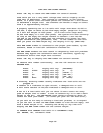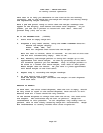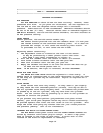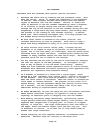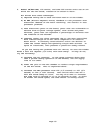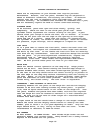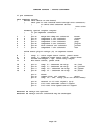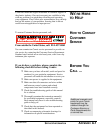MIX PROBLEMS
Customers with mix problems have several options available.
1. Decrease the batch size by lowering the FUL parameter value. This
does two things. First, it causes the components to be dispensed
in smaller, more frequent batches which places more and smaller
layers of material into the mix chamber. Second, it lowers the
level of material in the mix chamber immediately after a dispense.
It is critical to proper mixing that the mix blades reach up
through the top of the material in the mix chamber during mix time.
Dispensing a large batch may bury these blades, particularly when
the process is not running at full blender capacity. A smaller
batch size, while reducing throughput rate, will help prevent the
mix blades being covered during mix time.
2. Be sure level sensor is mounted in its lowest position, and
increase sensitivity as much as possible. Both serve to keep a
batch from being dispensed so early as to cover the mix blades.
3. On units without flow control valves (FCA), increase the DLY
parameter to as number as high as 50 percent of the time between
cycles. DLY is the time delay (in interrupts) from the sensor being
uncovered until we begin the batch. Increasing DLY allows the mix
chamber to empty somewhat before the next batch drops. The maximum
possible value for DLY is 29999 or 122 seconds.
4. You may increase the mix time at the end of each batch by changing
the last two digits of the MIX parameter. If throughput is very
high it may be better to run the mixer continuously. However,
added mix time sometimes causes separation after an initial mixing.
Different bulk densities and static electricity both aggravate this
potential for separation from excessive mixing.
5. If a blender is mounted on a stand over a surge hopper, there
should be a FCA, automatic flow control valve, fitted to the bottom
of the blender. This valve must be plumbed so that it is closed
when the level sensor is uncovered. When the sensor is covered the
valve opens to release material. The purpose of this valve is to
ensure mixing. The FCV parameter delays the opening of this valve
for 6 seconds. You can increase this delay time if you feel
additional mixing is required before release.
6. On model GB/WSB-940, be sure the weigh bin has two baffles installed.
These ensure horizontal layering (as opposed to side by side
layering) of materials prior to dropping into the mix chamber.
7. Bulk density and pellet shape differences, specifically smooth
virgin pellets mixed with square higher density color pellets, can
separate when dropped onto a sloping pile, as exists in a hopper,
Gaylord, or surge bin. The light round pellets flow like water to
the edges, while the heavier square color pellets stay put. This
is difficult to correct. It is best not to drop these kinds of
blends into large containers.
8. Vacuum conveying can also separate materials of different bulk
densities. Maintain high air velocity to minimize this.
Page 92



